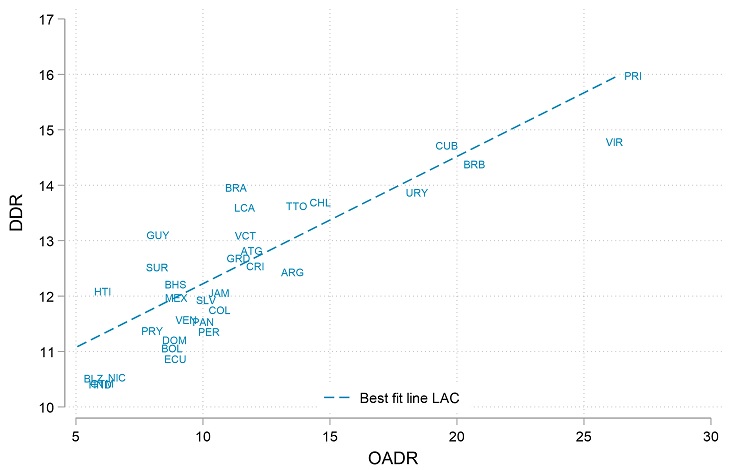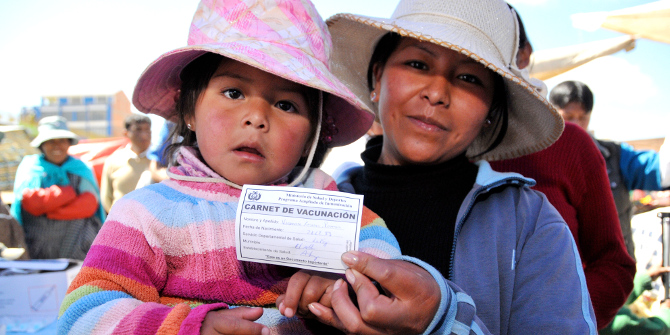The region is projected to experience a rapid change in its population’s age structure. The proportion of citizens older than 65 will more than double in the next three decades. However, rethinking ageing in terms of health is crucial to inform public policy, argue Diego Wachs (LSE) and Andres Roman Urrestarazu (Stanford University).
Lee este artículo en español
Latin America and the Caribbean will experience a rapid change in their population structure over the next decades. The ratio between people older than 65 and younger adults, the old-age dependency ratio (OADR), will increase by 11 and 14 percentage points over the next three decades, respectively. This context will likely affect economic growth and public fiscal accounts. However, the consequences of population ageing may be less worrying than what a measure like the old-age dependency ratio suggests.

A younger population in terms of capacity
At the biological level, the process of ageing is associated with gradual physiological changes. These changes increase the risk of many diseases and affect the general capacities of a person. Ultimately, these changes condition the capacity of individuals to achieve the goals they value, such as participating in the labour market or in social activities, according to the World Health Organization. But these changes are neither linear nor consistent, and they are only loosely associated with age in years.
Following this qualitative definition of ageing, we developed an indicator based on the physical characteristics of the population rather than their age. We define it as the disability dependency ratio (DDR). Following similar literature, we use data from the Global Burden of Disease database to quantify the ratio between the adult population with disabilities and the rest of the adult population. The disability indicators include a variety of domains, including cognitive and physical conditions that can be quantified into years of life lived in less than full health. The detailed protocol describing our approach can be found here.
Even though the old-age dependency ratio and the disability dependency ratio are positively correlated, there is variation across countries in the region. Ecuador and Guyana have the same age structure, but Guyana is much younger when looking at their disability dependence ratio. Likewise, the U.S. Virgin Islands and Nicaragua are comparably younger than Paraguay and Haiti.
Figure 2 shows a comparison bet for Latin American countries. In essence, countries that have an edge are those on the southern edge of the distribution depicted in this figure. This means that their capacity is young in relation to their old-age dependency ratio.

Many countries in Latin America and the Caribbean appear to have a lower disability dependence ratio than countries with a similar age structure. This means that they have lower disability prevalence rates across the population, even when controlled by age.
An easy method to depict what this means is to look at the age-standardized DDR. This is equivalent to asking what the DDR would be if all countries had the same age structure but maintained their rates of disability by age group. For example, how would regions compare if all countries had the population structure of Japan, the country with the highest share of people aged 65+ in the world?

When the comparison is based on the old-age dependency ratio, Latin America appears to be older than South Asia, the Middle East and North Africa, and South-Saharan Africa. The Caribbean is even older with the second to last highest OADR. However, the distribution is inverted when looking at the Standardized DDR.

The dynamics across countries can be extrapolated to the projected changes in age structure that Latin America and the Caribbean are expected to undergo over the next decades. If countries in the region are able to maintain or even reduce rates of disability over the coming decades, the effects of ageing on the economy will be partially mitigated. With these results in mind, it is evident that we need a perspective on ageing based on the population’s health and further research focused on the connection between individual autonomy, health markers, and behavioural factors in Latin America and the Caribbean is key for this endeavour.
Notes:
• The views expressed here are of the authors rather than the Centre or the LSE
• Please read our Comments Policy before commenting
• Banner image: Art DiNo (CC BY-NC-SA 2.0)





